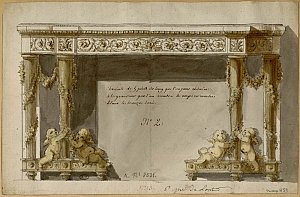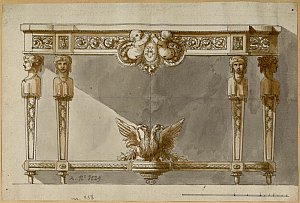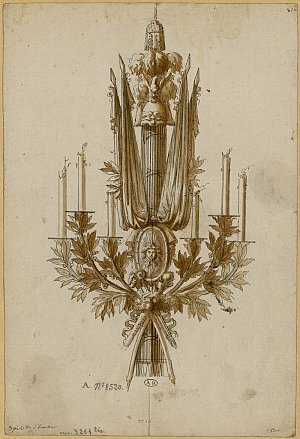The fireplaces

Modèle de cheminée masqué en console, Paris, vers 1771-1772
Papier vergé ; plume, encre noire, lavis gris, aquarelle sépia
Inv. 8531
© MAD, Paris
In the 18th century, marble fireplaces decorated with gilt bronzes were specially commissioned luxury creations. The drawing of a fireplace disguised as a console table has been identified as corresponding to the description in the 1779 inventory of the “small apartments” in the Palais Bourbon, the stylish mansion built in 1771-1772 by Billard de Bellissard for Louis-Joseph de Bourbon, Prince of Condé. The round, domed drawing room had a fireplace “with a white marble table supported by bronze legs gilded with ground gold. The firedogs are linked to these supports, so that it can effectively serve as a table in summer by adding the rear panel” 2. The number “2” written in ink suggests that this drawing may have been destined to be shown to a buyer, in this case the Duke of Bourbon. The model for a four-legged console table with adjoining firedogs is also a disguised fireplace, and probably a variation of the preceding project 3.
The console tables

Projet de console, Paris, vers 1775
Papier vergé ; plume, encre noire, lavis gris, aquarelle sépia
Inv. 8529
© MAD, Paris
The console table’s decoration usually echoed that of the fireplace because they were often placed opposite one another. On the rim of the four-legged table there is a medallion with two interlaced Ls. The presence of the royal monogram would indicate that this model was destined for the king, for whom Jean-Louis Prieur had already worked: in 1775, he delivered the bronzes of Louis XVI’s coronation carriage, after drawings by Bélanger. The intersection of the crossstruts is decorated with an eagle cut in two in the middle. The four tapering, rectangular legs are surmounted by busts of women “in the antique style.” This exceptional model for a console table is reminiscent of the luxurious example in the Frick Collection, created in Turquin blue marble around 1780, whose bronzes are attributed to Pierre Gouthière 4. A second project shows a “d’entre-deux” console table with one fluted leg with a satyr’s mask, one of the artist’s recurrent motifs, with radiating garlands of fruit and bunches of grapes 5.
The lamps

Modèle de lustre, Paris, vers 1770
Papier vergé ; plume, encre noire, aquarelle sépia
Inv. 8520
© MAD, Paris
Children, chubby, pot-bellied and often laughing, are frequently represented on Jean-Louis Prieur’s models for candelabra, torch lamps, bras de lumière
and chandeliers. The drawing of a wall lamp with two bras de lumière bears the
inscription “N°Ier” (ill. 4). It may also have been destined to be shown to a client
or marchand mercier (furniture supplier). Three candles rise from the arms in
the form of a horn of plenty. The lamp’s body is formed by a term figure of a
child bearing a basket of flowers on its head, from which garlands of beads are
departing to the horns of plenty. The model is large: “23 inches high” and “14
inches wide” (62.2 x 37.8 cm). The model for a six-branched chandelier, on the
other hand, has the rarer decoration of a military trophy 6. Formed by a lictor’s
fasces surmounted by a plumed helmet crowned by an eagle, the chandelier’s
stem is surrounded by four standards, above an oval medallion with a beaming
sun. The dimensions are also indicated: “3 ½ feet high” (approx. 1.13 m).